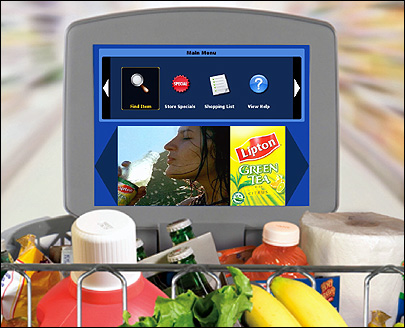Media Cart Holdings has developed a shopping cart that uses RFID technology to inform consumers about items they pass in a store as they shop. Two grocery retailers, one on the East Coast and a second in the Dallas area, will begin using the system—each in a single store—in about three weeks. Media Cart’s chief marketing officer, Jon Kramer, says the company is in discussions with numerous other “major retail stores” throughout the United States as well.
With the new RFID system, Media Cart installs Avery Dennison UHF Gen 2 passive RFID chips every 2 feet throughout a store’s aisles. The carts come equipped with a 12-inch high-resolution video display attached at the nose of the cart, facing the shopper. A ThingMagic 4E RFID interrogator and a power supply, both built by Media Cart, are attached to the bottom of the cart. When not in use, the units are parked in a corral so they can be charged.

Since late 2005, the company has been piloting the system in a 7,000-square-foot simulated store at its headquarters, near Dallas. The simulated store includes all the groceries found in a typical store, including freezer item goods, produce and a deli. During initial testing at the simulated store, Kramer says, it took shoppers time to adjust to the many features offered by the cart. Therefore, the company turned off all extra features for the pilot and provided only the most basic services—advertising specific to a particular location in the store. That same service will be launched in full deployment with the unnamed East Coast grocery retailer, Kramer says. Within weeks, as shoppers get used to the cart, more features will be added.
With the basics in operation, once a shopper takes a cart from the corral, a welcome message will be displayed on the screen. As the shopper passes through each aisle, the interrogator will capture unique ID numbers from every RFID tag within a read range of about 8 feet. The ID numbers are associated with that particular section of the store, and the cart screen begins displaying specific advertisements for products the shopper passes, alerting him to sales and coupons.
“We keep track of all the data,” says Kramer, though Media Cart may integrate the system with the retailer’s back-end system, if requested.
Once all the features become available, shoppers will be able to log onto a store’s Web site, input a shopping list and receive an ID number. They can then provide that number to the media cart at the time of shopping, and the cart will list the items in order of their placement throughout the store. It can also recommend recipes, list the products needed for those recipes and direct shoppers to their location in the store. The customers can then opt to receive the recipes via e-mail.
Additionally, the cart has a built-in bar-code scanner allowing shoppers to scan items while putting them in the cart. This is intended to spare them from having to wait in line at checkout while a cashier rings up each item. In the case of produce or deli items, stores would have to install printers to their scales so customers could weigh an item, print the weight and price on a bar-code label and scan the label at the cart.
As a shopper completes the process and leaves the store, the cart says goodbye on its display screen and is taken to the corral for recharging, where it wirelessly sends data about the items purchased to a Media Cart server. The server then routes that data to the company’s data warehouse, located in Dallas.
Media Cart Holdings is not the first company to develop an RFID-enabled shopping cart to provide shoppers with information inside the store. (See Grocery Retailers Test RFID-enabled Shopping Carts and RFID for Your Shopping Cart for additional examples.) However, one feature that sets its cart apart from the others’, the company says, is that it will cost retailers about the same as a typical shopping cart, while consumer packaged goods (CPG) companies will pay a per-click fee to display advertisements for their products. Retailers will pay about $150 for the cart, which will be installed and maintained by Media Cart.


